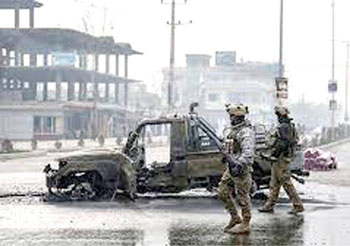To improve the security situation in Kabul, the Kabul Security Command said that it has started the installation of security cameras in the city.
According to this institution’s figures, more than 2000 security cameras have been installed throughout Kabul, and work is still being done to put cameras in more areas of the city.
“Installing cameras is voluntary and not mandatory for every citizen, but the owners of big townships are obligated to install cameras close to their gates,” said Khaled Zadran, spokesman of the Kabul Security Command.
Meanwhile, some Kabul residents said that they cannot afford to buy security cameras due to economic problems, and the Islamic Emirate should not make it mandatory.
“How can you activate security cameras and avoid incidents when there is no electricity?” said Mohammad Hadi, a resident of Kabul.
“People’s economic situation are not good, and they can’t afford five or six thousand Afghanis to buy a camera. Security cameras cost money,” said Mir Ahmad, another resident of Kabul.
However, some military experts said that it is the government’s duty to install security cameras.
“Installing security cameras and operating them in accordance with the law, customs, and culture of the people is one of the tasks of the government,” said Asadullah Nadim, military expert.
According to the Kabul Security Command, installing security cameras is obligatory in the major townships but optional in other areas of the city.
The former Afghan government began the process of installing security cameras on Kabul’s roads in October 2020 to ensure the safety of the city.
Meanwhile, clashes have intensified in northern, northeastern and southern parts of the country as the weather is changing.
In a recent incident on Monday night, at least eight members of the Afghan police were killed in an attack by the Taliban in northern Balkh province.
The announcement of the security plan comes amid the increasing efforts for peace by the Afghan government and its international allies including the United States.
In a report released in February, the United Nations said the organization has documented 3,804 civilian deaths, including 927 children, in 2018.
In total, UNAMA documented 10,993 civilian casualties (3,804 deaths and 7,189) wounded), representing a five percent increase in overall civilian casualties and an 11 percent increase in civilian deaths compared with 2017.
In this report, UNAMA attributes the majority of civilian casualties – 63 percent – to anti-government elements (37 percent to Taliban, 20 percent to Daesh, and 6 percent to undetermined anti-government elements).
According to the report, pro-government forces caused 24 percent civilian deaths (14 percent by Afghan national security forces, six percent by international military forces, and four percent by other pro-government armed groups and forces).
The report says that key factors contributing to the significant increase in civilian casualties were a spike in suicide attacks by anti-government elements, mainly Daesh, as well as increased harm to civilians from aerial and search operations by pro-government forces.
The report says that 2018 witnessed the highest number of civilian casualties ever recorded from suicide attacks and aerial operations.—Tolonews










